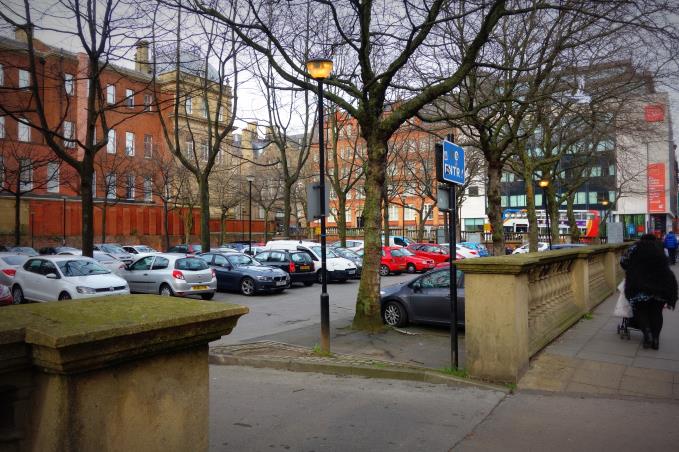LIVERPOOL'S tree-lined Victoria Street car park will be wiped out to pave the way for a 250-space multi-storey car park under plans published by the council today.
The area became open space, thanks to a German bombing raid in 1941, eventually becoming a surface car park.
Closing the leafy car park may be a good idea, if the aim was to create a London-style square where city centre workers can escape to a green oasis.
But there is, within the city centre, a lack of green, break-out areas, and a distinct absence of trees, and here there are 34.
People are encouraged to walk, cycle and exercise, yet here is a scheme to erase one of the last areas of greenery to allow even more cars into the congested central area
Liverpool Confidential revealed a while ago plans for mini-parks in Bold Street, such was the clamour to allow people to take a step back into something more natural. In the early 2000s, it was the obvious choice for Liverpool's first farmers market, every Saturday morning, when traffic to that part of town was light.
Once Victoria Street car park is gobbled up by a forest of steel and concrete one of the last opportunities to develop a mini park will be gone forever.
As party of healthy Liverpool initiatives, backed by the council, people are being encouraged to walk, cycle and exercise, yet here is a scheme to erase one of the last areas of greenery to allow even more cars into the congested central area.
Even as a ground-level car park it earns its keep for the council, generating an income of around £400,000.
Once the multi-storey is built and operating, the income from parking will not be that much more after interest payments on the money borrowed to pay for the scheme. It will be the 2020s before it starts to earn significant money.
 Chopping spree: London's Russell Square, but where are Liverpool's break out green spaces to briefly escape from the clamour of urban life?
Chopping spree: London's Russell Square, but where are Liverpool's break out green spaces to briefly escape from the clamour of urban life?
Nobody would even think of encroaching on the great squares of London where visitors, residents and city workers can enjoy a brief encounter with nature.
The plan is being put forward by Cllr Malcolm Kennedy, as well as being responsible for regeneration he is also the cabinet member for climate change. He says the cost of building the multi-storey (in sympathy with the conservation character of the area) will be between £4.5m and £5.5m.
“The design will be respectful to the character of the conservation area and the heritage and re-provision of any lost trees will be a requirement of the project. The intention is for the City Council to self fund the design and build of the multi-storey car park and then manage and maintain the development in house once open,” says Cllr Kennedy.
Mayor Anderson is backing the recommendation for the multi-storey, with retail space (perhaps for a restaurant on the ground floor). It will be put to the city council cabinet next Friday with a recommendation to give the thumbs up to the multi-storey.
Government buildings bombed in the war

Maps from the 1860s show the site of the car park occupied by a large building with an internal courtyard named Government Buildings. In the 1930s they show the city’s courtrooms were housed in this building along with various administrative offices of the Liverpool Corporation.
During a WW II bombing raid on Liverpool the Government Buildings were destroyed. Following the end of the war the site was cleared and developed into car park to serve surrounding buildings with the growth of personal transport.
Apart from minor alterations to boundaries and surfacing, the site has remained largely unchanged from this period to the present day. Except for an abundance of foliage.
The existing car park is bounded by Victoria Street, Crosshall Street, Sir Thomas Street and Grade II* listed Municipal Building. The Municipal Building sits within the UNESCO World Heritage Site designation. The Municipal Building is presently occupied by the City Council housing circa 600 staff across a number of directorates. The existing car park provides 122 car spaces.
There are currently 34 trees on the site, but their condition is variable, says the council, with a recent initial assessment saying the majority are believed in poor state of health.
The car park itself is located within the Castle Street Conservation Area. The trees are not subject to a tree preservation order, but add to the character of the Conservation Area.













